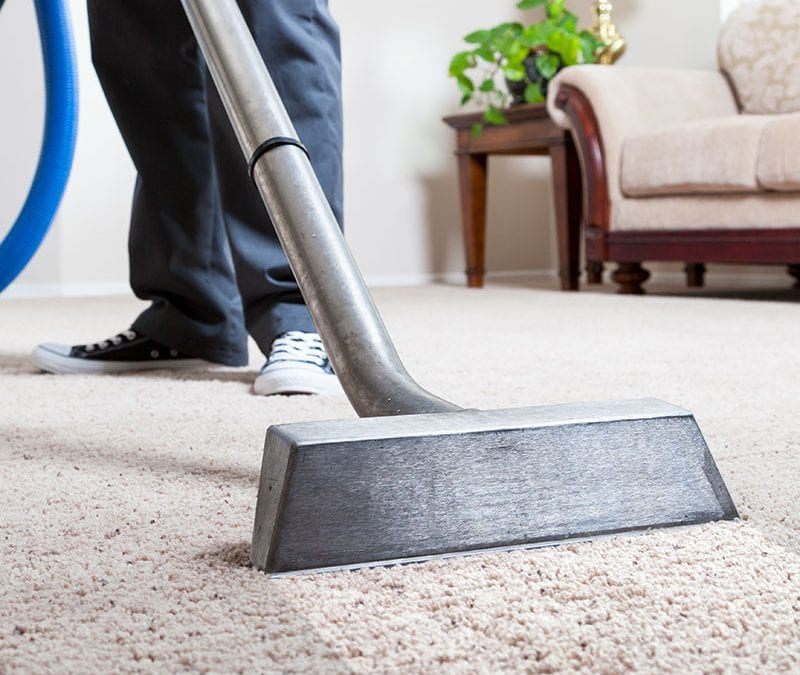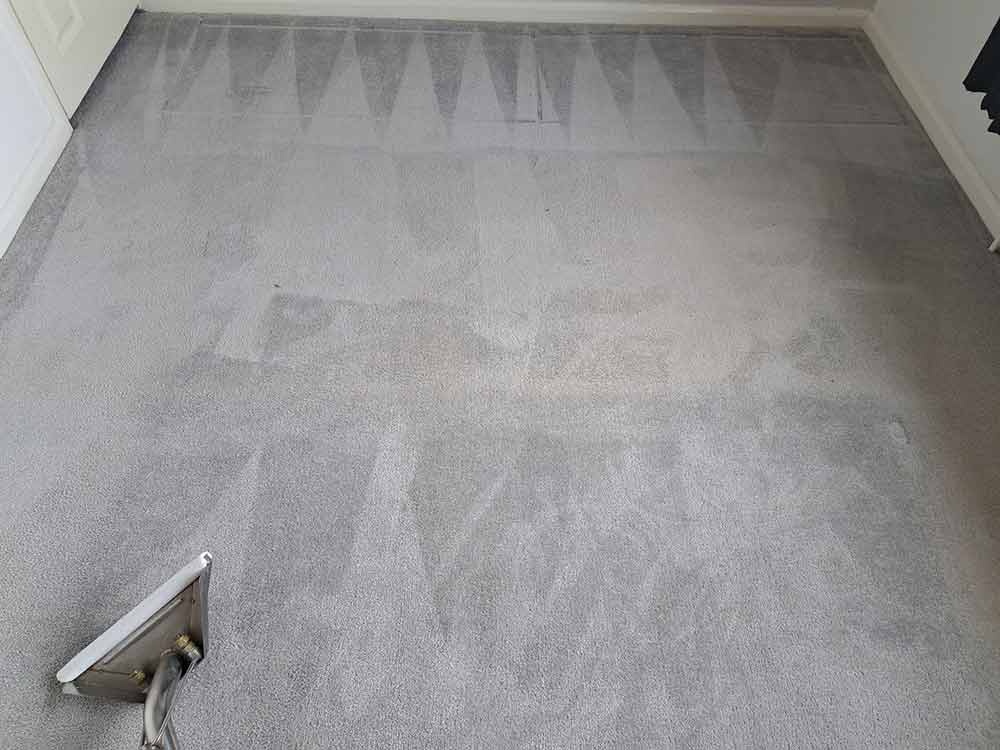Most people don't realize that the way you care for your distressed hardwood floors can greatly impact their lifespan and appearance. While sweeping and mopping may seem straightforward, there are specific techniques and products that can either help or hinder your efforts. You might be surprised to learn how simple changes in your cleaning routine can yield impressive results. Understanding these nuances will not only enhance the beauty of your floors but also protect your investment in the long run. So, what steps should you take to guarantee your floors remain in top condition?
Importance of Regular Cleaning
Your hardwood floors represent a significant investment in your home, and regular cleaning is essential to protect that investment. One of the primary cleaning benefits is the preservation of the wood's surface, preventing damage and maintaining its natural beauty, color, and shine.
By promptly addressing spills and moisture, you can prevent warping or buckling, which are costly issues to rectify.
Adopting effective maintenance strategies, such as using soft-bristled brooms and microfiber mops, guarantees that dust and debris are gently removed without scratching the surface.
It's imperative to use pH-neutral cleaners specifically designed for hardwood floors to avoid any chemical damage. Avoiding excess water is also essential; using a fine spray mist instead of a wet mop can save your floors from water-related problems.
Daily dusting is critical, especially in high-traffic areas, to minimize allergens and maintain a healthier living environment.
Additionally, keeping an eye on factors like foot traffic and sunlight exposure can help you adjust your cleaning frequency, making sure your floors remain in excellent condition.
Regular cleaning not only enhances the appearance of your floors but also preserves their longevity.
Preventing Floor Damage
Preventing damage to hardwood floors is essential for maintaining their elegance and extending their lifespan. Start by utilizing furniture pads, which act as a cushion between your furniture and the floor, preventing scratches and gouges. Choose the right type of pads—felt, rubber, or glides—and stick them to the bottom of furniture legs. Replace them when they wear out, especially for heavy furniture, where larger pads help distribute weight and reduce indentation.
Moisture control is vital, too. Clean spills immediately to prevent moisture from seeping into the wood. Use minimal liquid when mopping, and always wipe up standing water right away. To maintain consistent humidity levels, consider using humidifiers to prevent wood from shrinking or expanding.
Here's a quick reference table for your convenience:
| Prevention Method | Details |
|---|---|
| Furniture Pads | Stick to furniture legs; replace when worn out. |
| Immediate Spill Cleanup | Always clean spills promptly. |
| Humidity Control | Use humidifiers for consistent levels. |
| Area Rugs | Place in high-traffic zones for protection. |
| Regular Maintenance | Sweep, vacuum, and mop with care. |
Restoring Distressed Floors
Restoring distressed hardwood floors involves a systematic approach to revive their original beauty and functionality. Begin with a thorough floor assessment to identify common issues like wear and tear, improper fitting, or previous repair mistakes. This evaluation is essential for determining the most effective restoration techniques.
Once you've assessed the floor, start with a detailed cleaning to remove grime and scum buildup. Afterward, secure any loose boards using glue to prevent further damage.
Sanding is a vital step; use advanced sanding equipment and a gradual approach, starting with coarse-grit sandpaper and progressing to finer grits. Hand-sanding in detailed areas guarantees precision.
Multiple passes may be necessary for a flawless finish, so be diligent in dust removal using appropriate tools such as China-bristle vacuums and microfiber towels.
After sanding, you can choose from various finish options like lacquer or oil, depending on your desired outcome.
If the damage is extensive, consider professional services that offer extensive restoration. They provide expertise in various floor types and often include free consultations, guaranteeing you revive your hardwood floors to their former glory.
Choosing Cleaning Products
After addressing the restoration of distressed hardwood floors, it's important to focus on maintaining their beauty through proper cleaning.
Choosing the right cleaning products is essential to avoid damaging the finish. Steer clear of oil-based products, ammonia-based cleaners, abrasives, vinegar, and steam, as these can harm your floors. Furniture polish is also a no-go; it can create a slippery surface.
For effective cleaning, consider eco-friendly options that are safe and effective. Bona Hardwood Floor Cleaner is a top choice, specifically formulated for hardwoods, and comes in a ready-to-use spray bottle.
Pallmann Hardwood Floor Cleaner Concentrate offers a pH-neutral formula, ensuring a streak-free finish without sticky residue. If you have hardwax oil floors, NWP Floor Soap and NWP Wax Care are excellent for stain removal.
For routine maintenance, a simple mix of plain soap and water can suffice.
Always remember to dry clean your floors. Use a damp, well-wrung mop with diluted cleaner to prevent excess water.
Professional Maintenance Options
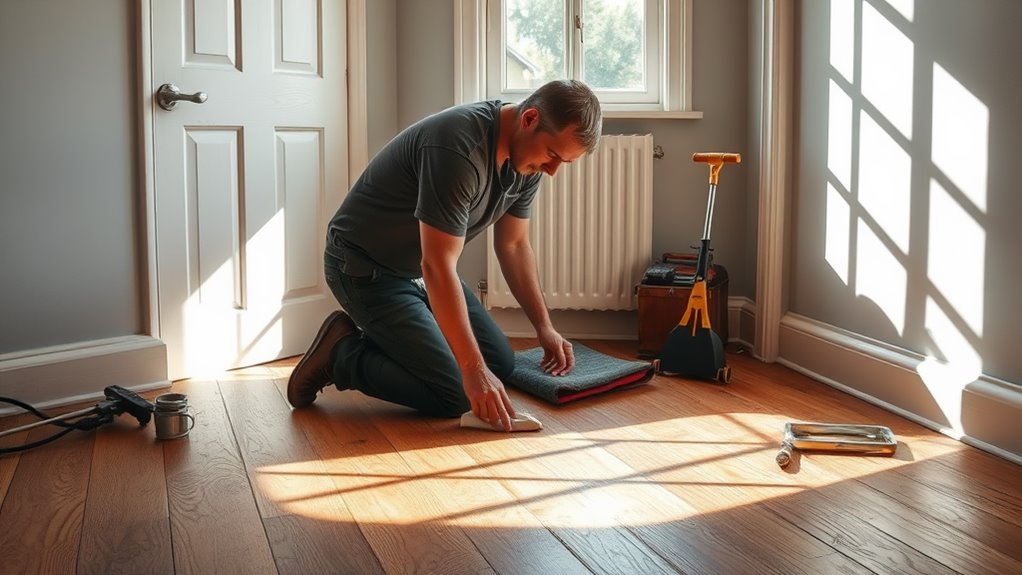
Professional maintenance options for hardwood floors can greatly enhance their longevity and appearance. Engaging a professional service in Nottingham, like Mr Sander or Sand and Sealed Ltd, guarantees skilled floor sanding and restoration using advanced technology.
These experts conduct thorough professional inspections to assess your flooring, identifying any necessary repairs or damage prior to starting the sanding process. They remove furniture and secure loose boards, preparing the area for dust-free sanding, which minimizes mess and disruption.
Once the groundwork is laid, they utilize state-of-the-art sanding equipment to eliminate imperfections and old finishes layer by layer. You'll benefit from a selection of finishes tailored to your style, including natural oils, waxes, and varnishes, all designed to enhance the wood's natural beauty.
In addition, they provide expert consultations to guide you in maintaining your floors post-service. Regular maintenance recommendations include periodic cleaning with professional products and light sanding every 5-7 years.
DIY Care Techniques
Caring for hardwood floors yourself can be a rewarding experience, allowing you to maintain their beauty and durability without relying on professional services. Here are some DIY techniques for scratch repair and wood staining to help restore your floors:
| Technique | Instructions |
|---|---|
| Scratch Repair | Sand the area with 60-grit sandpaper to smooth out imperfections. Fill small scratches with matching wood filler using a putty knife. For deeper scratches, mix baking soda and olive oil, rubbing it in with a soft cloth. Finally, use a wood stain marker to blend and hide any remaining scratches. |
| Refinishing | Start by cleaning with an industry-approved product and a maroon pad. Sand the floor with industrial sandpaper, working in small sections. Apply finish using a China-bristle brush, covering 2-foot rows. Wipe down and tack with a dampened rag to guarantee a clean surface. |
| Patching Planks | Remove damaged planks using a circular saw and chisel. Cut replacement planks to size, securing them with a pneumatic nail gun. Fill nail holes with stained wood putty, sanding to blend. |
| Final Touches | Lightly sand repaired areas and vacuum dust thoroughly. |
These techniques can help you maintain the integrity of your hardwood floors effectively.
Daily and Weekly Routines
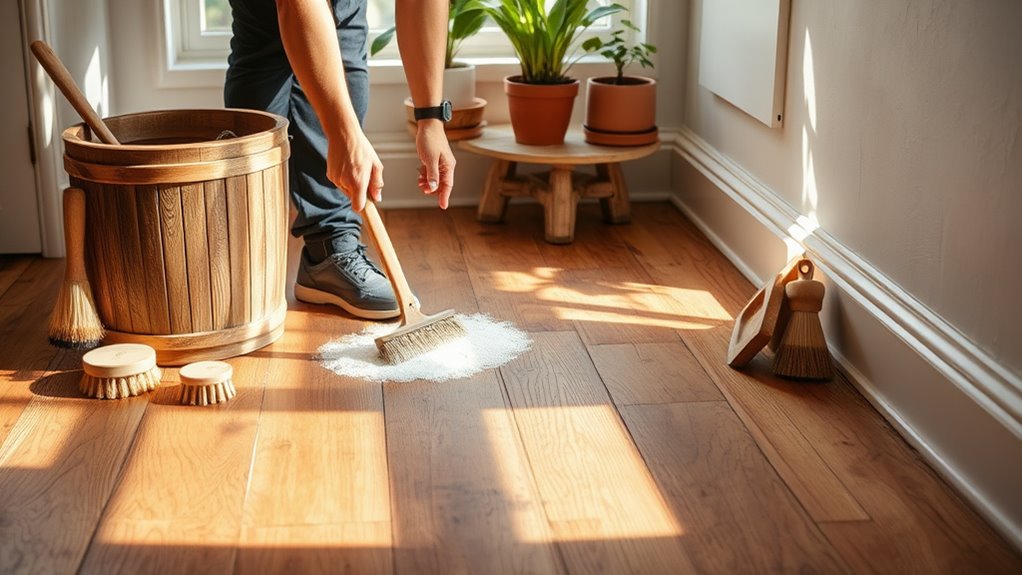
Regular maintenance is essential for keeping your hardwood floors looking their best and extending their lifespan. Implementing daily and weekly routines can greatly help in preserving their quality. Here's a concise guide to your maintenance tasks:
- Daily Maintenance:
- Sweep or dust using a microfiber mop or a nylon bristle broom to eliminate dust and dirt. This prevents scratches and damage from grit build-up.
- Immediately clean any spills with a damp cloth to avoid moisture damage.
- Place felt pads under furniture and area rugs in high-traffic zones to minimize wear.
- Weekly Routines:
- Vacuum your hardwood floors weekly, particularly in busy areas. Use a canister vacuum with a soft bristle brush attachment, avoiding rotating power heads.
- Inspect and replace felt pads under furniture as needed.
- Lightly mist your microfiber mop with a recommended wood cleaner for a deeper clean.
- Preventative Measures:
- Regularly check your pets' nails and keep them trimmed to reduce scratches.
- Maintain proper humidity levels in your home to prevent floor issues.
Tips for Spot Cleaning
Effective spot cleaning is essential for maintaining the appearance and integrity of your hardwood floors, especially when dealing with stubborn stains or spills. Start by addressing spills immediately to prevent water damage.
Use hardwood floor cleaners designed for your specific finish to avoid common mistakes that can harm your floor. For water stains, try using #000 steel wool, while tough stains may require light sanding followed by cleaning with #00 steel wool. Oil and grease stains can be treated with hydrogen peroxide layered on cotton.
When applying spot cleaning techniques, always avoid wet mopping and harsh chemicals, as these can damage your floor and void warranties. Stick to soft cleaning tools, like soft-bristled brooms and vacuums made for hardwood.
After cleaning, make certain you dry the area thoroughly to prevent further damage. Additionally, maintain a consistent humidity level in your home to preserve your floor's integrity.
Using Mats and Rugs
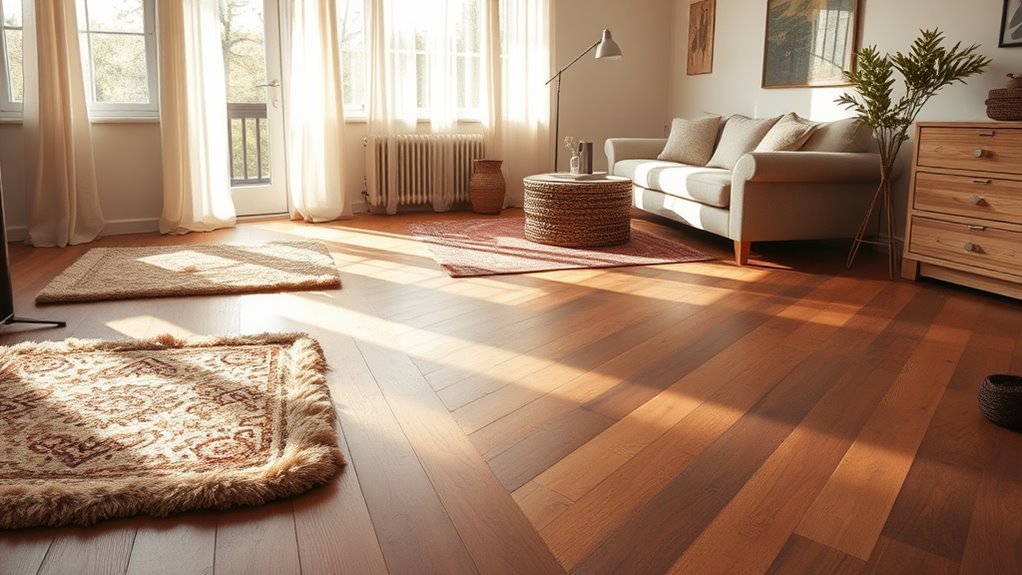
Maintaining the beauty of your hardwood floors goes beyond spot cleaning; using mats and rugs plays a crucial role in their preservation. The right choice of rug materials and their strategic placement can greatly reduce wear and tear.
- Material Considerations: Opt for natural fibers like jute, sisal, or seagrass, or choose durable wool rugs, which are naturally stain-resistant. Avoid rugs with rubber or plastic backings as they can cause discoloration.
- Rug Placement: Position rugs in high-traffic areas to shield your hardwood from damage. Large area rugs work well for living and dining rooms, while runner rugs are perfect for hallways and entryways.
- Rug Pad Importance: Always use a high-quality rug pad to enhance grip and prevent slipping. Custom-cut pads offer extra protection and help distribute the rug's weight evenly.
Regularly maintain your rugs by vacuuming and cleaning them to prevent dirt buildup.
Additionally, inspect both mats and rugs for wear and tear to guarantee they continue to protect your hardwood floors effectively.
Prioritizing these steps will help extend the life of your floors.
The Role of Sunlight
Sunlight can have a profound impact on the appearance and longevity of your hardwood floors. The sunlight effects, particularly from UV rays, trigger a chemical process known as photochemical oxidation, leading to color fading.
Depending on the wood species, you might notice varying degrees of discoloration; for example, Maple and Brazilian Cherry tend to darken, while Red Oak and Hickory lighten over time.
Several factors contribute to this fading, including not just UV light, but also visible and infrared light, which generates heat. Tropical woods generally react faster to sunlight exposure compared to domestic woods, making it vital to monitor your flooring's condition.
To mitigate sun damage, consider using window treatments, such as curtains or blinds, to block harmful rays.
Applying UV-blocking finishes on your floors can also provide essential protection. Regularly rearranging furniture and area rugs helps equalize UV exposure and maintain color consistency.
Finally, keep an eye on sunlight levels in your home, adjusting as necessary to prevent excessive exposure. By taking these steps, you can greatly prolong the life and aesthetic appeal of your hardwood floors.
Frequently Asked Questions
How Often Should I Refresh My Hardwax Oiled Floors?
You should refresh your hardwax oiled floors every 3-4 years for ideal protection. Regular hardwax maintenance, including periodic maintenance coats, helps prolong the floor's finish and enhances its durability against daily wear and tear.
Can I Use Steam Cleaners on Distressed Hardwood Floors?
You shouldn't use steam cleaners on distressed hardwood floors due to moisture risks. For ideal steam cleaner safety, follow hardwood maintenance tips like regular vacuuming, damp mopping, and using pH-neutral cleaners to protect your floors.
What Are the Signs My Hardwood Floors Need Professional Help?
Did you know that 30% of hardwood floors suffer from wear by the time they're ten years old? If you see scratches, warping, or gaps, it's time for a professional assessment to guarantee proper floor maintenance.
How Do I Remove Deep Scratches From Distressed Hardwood?
To remove deep scratches, apply wood filler with a putty knife, sand it smooth, and match the stain. Regular floor maintenance helps prevent scratches, ensuring your hardwood remains beautiful and well-preserved for years.
Is It Safe to Use Vinegar on Hardwood Floors?
Imagine a brave knight wielding vinegar as a sword. While it can shine hardwood's armor, improper use risks tarnishing its brilliance. For hardwood maintenance, dilute vinegar wisely to harness its benefits without harm.
Conclusion
Caring for distressed hardwood floors in Nottingham is a delicate balance between beauty and practicality. While regular cleaning keeps dirt at bay, immediate spill responses protect your investment. Choosing eco-friendly products safeguards the wood's integrity, contrasting harsh cleaners that can cause lasting damage. Professional restoration brings back the floor's original charm, while managing sunlight exposure preserves its color. By implementing these strategies, you guarantee your floors remain a stunning focal point, effortlessly blending aesthetics with durability.

